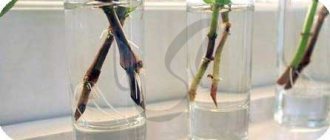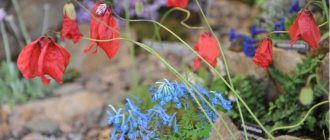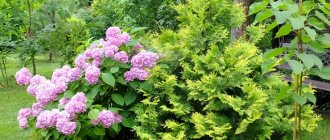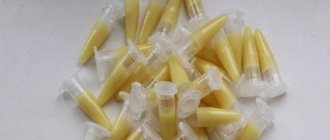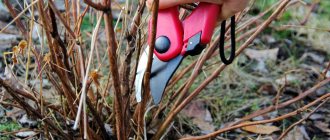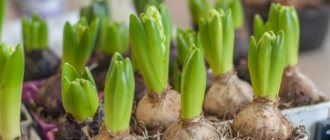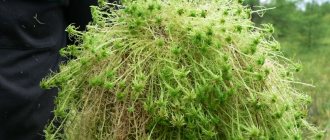Plant propagation by bulbs, tubers, corms and tubers
Today we will look at several more methods of vegetative propagation of plants, such as propagation by tubers, propagation by bulbs, propagation by corms and tubers.
Propagation by tubers
A tuber of stem origin is a greatly shortened and thickened stem (or part of it), carrying reserves of nutrients and renewal buds (eyes).
- Perennial tubers are mainly storage organs (corydalis, cyclamen), while annual tubers also serve as reproductive organs (potatoes, horsetail, etc.).
- Stem tubers should be distinguished from root tubers. The latter are formed as a result of thickening of the roots (for example, in peony, dahlia), do not have renewal buds and are unsuitable for propagation without the corresponding part of the rhizome.
Propagation by bulbs.
Bulbs are underground perennial, greatly shortened shoots, the stem of which has turned into the so-called bottom.
The leaves are thickened and form bulbous scales. Nutrients are deposited in the leaves.
At the top of the bottom inside the bulb there is a bud. In spring it develops into a shoot with a flower. At the base of the bottom, adventitious roots appear.
In addition to underground ones, there are above-ground bulbs. They are formed in the axils of leaves (tiger lily, bulbous lily), sometimes in inflorescences (multi-tiered onion).
The bulbs are replaced annually or accumulate scales over several years and become perennial. In this regard, a distinction is made between bulbous plants with annual replacement bulbs (tulip) and perennial bulbs (lily, narcissus, galanthus, scylla, hyacinth, muscari).
They reproduce by forming replacement and lateral bulbs, which develop from buds located in the axils of the scales of the mother bulb.
Watch a video about the propagation of various bulbous plants.
Vegetative propagation by corms and tuber buds.
Corms include: gladiolus, crocus, colchicum, etc. Plants of this group reproduce by corms and tuber buds - children.
The corm consists of a tuberous overgrown part of the stem and scales.
In its origin and functions, it is close to the onion and differs from it in the larger size of the stem part, where reserves of nutrients are deposited.
The leaves do not take part in the formation of the corm and function as coverings.
Watch the video on how to properly propagate by dividing a tuber using peonies as an example.
Previous entry: Reproduction by layering - propagation by air layering, etc.
Next entry: Reproduction by grafting
Vegetative propagation of angiosperms
Plants are classified as asexual
and
sexual reproduction
. Asexual reproduction is divided into sporulation and vegetative.
Let's consider methods of vegetative propagation.
The first method we will consider is the natural formation of root suckers.
This method of vegetative propagation is characteristic of raspberries: young shoots are formed on the roots of adult plants, which later form their own root system.
After several weeks, when the young shoots grow completely independently, they are dug up and replanted.
The next method of vegetative propagation is propagation by tuberous roots.
The tuberous roots of the dahlia develop anew every year. Every year, due to the reserves contained in the tuberous roots, the plant develops a new above-ground part, after which the roots die.
Before growing plants, the tuberous roots are divided into parts so that each has at least one bud, from which a new shoot will develop in the future. The cut surfaces are treated with powder against fungal diseases.
The prepared roots are planted in the soil mixture. No watering is needed. The pots are kept in a place protected from frost, and when shoots appear, they are brought out into the light.
Another method of vegetative propagation is propagation by underground modified shoots.
There are six main types of modified shoots
:
tuber
,
rhizome
,
corm
,
bulb
,
tendril
and
scion
. They should not be confused with modifications of root systems that do not have all the features characteristic of the stem.
The difference between a modified shoot and a regular one is that it does not necessarily grow above the ground, its growth is often more or less horizontal and it is usually a container for reserve nutrients.
Propagation by tubers
Perhaps the most famous of the tuber-forming plants is the potato. Using a sharp knife, the tuber is cut into pieces so that each of them has at least one well-developed eye (or bud). The surface of the cuts is treated with special antifungal drugs.
Parts of the tuber are planted. The depth of the planting hole should be approximately twice its diameter.
Propagation by rhizomes
Much better than other garden plants, they can be propagated by rhizomes .
German rice.
The most suitable time for dividing and planting rhizomes is immediately after flowering, when the old root system dies off and a new one begins to form.
A large rhizome is dug out of the ground with a pitchfork and thoroughly shaken. The old parts of the rhizome are cut off, leaving only this year's young growth. The roots are trimmed to 5-7 centimeters in length; Leaf blades are also shortened to reduce water evaporation.
Parts of the rhizome are planted at the same depth at which they grew before; for iris this is practically the surface of the soil.
Propagation by corms
The corm is shorter and wider than the bulb; leaves that have turned into thin dry films are placed on it, covering it and protecting it from damage and drying out; in the axil of each leaf there is a bud.
Immediately before planting, a large healthy corm is cut into several parts that have at least one bud. The surface of the cuts is treated with antifungal powder. Then the corm pieces are planted in pots or open ground.
Propagation by bulbs
In tulips, the bulb disintegrates after flowering, leaving behind, along with the bulb capable of flowering, also small bulbs. In the fall, they are planted, placing them at a depth twice their size.
In some lilies, just below the surface of the earth, below or above the main bulb, children are formed - small bulbs
.
At the end of summer, they are carefully separated and planted, like the bulb itself, at a depth of approximately twice their size.
In certain types of bulbous plants (white lily), small aerial bulbs may form on the stem.
They are collected as they ripen and planted.
In gardening, bulbous plants are propagated by cutting the bottoms of the bulbs.
From the bottom side, two intersecting cuts are made through the bottom of the hyacinth bulb. Keep the bulb in a warm, dry place until the cuts open. Over time, bulbs form in the cuts.
Let's see how vegetative
propagation occurs through the formation of whiskers.
A classic example of a plant that reproduces naturally in this way is strawberries. Young plants usually root fairly quickly and in turn form new tendrils.
Sometimes holes are dug in the ground near the mother plant and pots with soil mixture are placed in them.
Reproduction by offspring
Offspring
- This is a side shoot, aboveground or underground, formed from a bud in the area of the root collar.
The suckers that form in most plants, such as young ones, take root slowly. To speed up propagation, the offspring are usually separated from the mother plant in the spring and planted in open ground.
Vegetative propagation of some plants is possible by dividing the bush.
The mother plant is dug up and the soil is shaken off from its roots, then washed with water. The bush is cut into several parts with a knife. Their sizes are arbitrary, but each must have at least one well-developed shoot. Planting material is planted in the ground.
Reproduction of woody plants by layering
- one of the oldest methods used in gardening. It involves stimulating the formation of roots on the stem before it is separated from the mother plant.
When propagating by layering, the lower branches of the mother plant are bent in an arched manner to the soil, the bark under the bud is cut and sprinkled with soil. When roots and above-ground shoots appear at the site of the incision, the young plant is separated from the mother plant and replanted.
Propagation by lignified cuttings
Cutting
- This is a specially separated part of the plant that is used for vegetative propagation.
Lignified cuttings are harvested during leaf fall and shortly before leaf buds open. An oblique cut is made above the future apical bud. A horizontal cut is made 15 cm below. The lower cut is treated with a special substance for root growth and planted in prepared soil. By autumn, adventitious roots grow on the cuttings. Then the cuttings are dug up and planted in a permanent place.
Propagation by cuttings from a leaf blade with a petiole
Using a sharp knife or safety razor blade, cut a suitable leaf through the petiole. Approximately a 5-centimeter piece of petiole is left at the leaf blade.
The cuttings are planted in the substrate at a certain angle so that the leaf blade almost lies on the surface. The prepared cuttings are placed in conditions with constantly maintained high humidity so that the cuttings do not dry out.
After 5-6 weeks, young plants will appear, there may be several of them. When they grow enough to be picked up by hand, the plants are separated and planted in pots.
Vegetative propagation of some plants is also possible by leaf embryos
On Kalanchoe leaves, leaf embryos form between the jagged edges of the leaf blade.
Young plants formed under natural conditions usually fall to the ground on their own as soon as roots begin to form.
In horticulture, grafting is used to propagate fruit plants .
Vaccination
called the connection of two parts of different plants, as a result of which they grow together and continue to grow as a single organism.
Bud-eye
or a cutting of a cultivated plant is spliced with a wild stem.
Wilding
is a young plant grown from the seed of a fruit tree.
The eye or cutting of a cultivated plant taken for grafting is called a scion
, and the wild one to which it is grafted is called
a rootstock
.
For kidney grafting
in the second half of summer, an annual shoot is cut from a cultivated fruit tree. The leaf blades are removed from it, leaving only the petioles. At the base of the stem of the wild rootstock, a sharp knife is used to make an incision in the bark in the shape of the letter T. By turning the knife blade in the cut, the bark of the wild rootstock is separated from the wood. Then, from a shoot of a cultivated variety, a well-developed bud with a thin layer of wood 2–2.5 cm long is cut off and inserted under the bark of the cultivar into a cut. The grafting site is tightly tied, so that the kidney itself remains free from the binding.
If the grafting is done correctly, after 2-3 weeks the rootstock will grow together with the scion, and in the spring of next year a shoot will develop from the grafted bud. After this, the stem must be cut above the grafting site. After 2-3 years, the shoot will turn into a cultivated tree that can be planted in the garden.
Grafting with cuttings
Produced in the spring, before the buds begin to grow. A cutting cut from a cultivated plant is connected to the stem part of the rootstock.
For grafting to be successful, you need to press the cambium of the scion to the cambium of the rootstock. The grafting site is tied with a tape made of plastic film, and the cut of the hemp is coated with varnish. Var
- This is a composition of boiled resin with impurities of wax or sulfur. If the grafting is done correctly, the rootstock will fuse with the scion and the scion buds will begin to bloom.
Division of root tubers
Division of root tubers
This operation is performed in closed ground conditions (tuberous begonia, gloxinia, buttercups). Queen cells are stored during the winter at a temperature of 0-5°C. Before division begins, the root tubers are germinated and, after the buds (eyes) are clearly identified, they are cut so that each separated part has a root collar, or a piece of the bottom, or at least one, but preferably 2 - 3 renewal buds. The difficulty is as follows : during division, a large wound surface is formed, as a result of which there is a danger of infection of root tubers with pathogens of fungal diseases. Therefore, the cuts must be treated with a fungicide or charcoal, and then dried for several days in a dry room at a temperature of 20-22 degrees C. so that the wounds heal. The prepared cuttings are planted in separate pots for growing. The peculiarity of this method is that each division must have a piece of the root collar. It should be noted that propagation by dividing root tubers is used quite rarely, and it is better to replace this operation with stem or leaf cuttings.
Graft
Vegetative propagation by grafting differs significantly from all other methods of propagation. Grafting requires the presence of two plants that grow together to form a single organism.
The plant on which the grafting is made is called the rootstock, and the plant (more precisely, part of it - a cutting, a bud) grafted onto the rootstock is called a scion.
The rootstock, having a root system, supplies the scion with water and mineral nutrients dissolved in it from the soil, while the scion provides the entire plant, including the rootstock, with organic substances and products of photosynthesis.
Grafting is used to propagate forms and varieties that, when propagated by seed, do not retain their decorative qualities, are difficult to take root when cuttings, or are poorly propagated by division.
In some cases, this method of vegetative propagation creates advantages:
- better flowering than that of self-rooted plants (azaleas, phyllocacti, roses, etc.);
- decorative crown forms (weeping, etc.);
- reducing the growing period of a crop by grafting weakly growing varieties onto vigorous rootstocks (roses on cuttings of Sukhumi polyantha, azaleas on rhododendron), etc.
Grafting with a bud (eye) is called budding, which is done with a growing (spring) or dormant (summer) eye.
Grafting with a cutting involves many different techniques, the most important of which are: simple copulation, improved copulation with a tongue, split grafting, grafting behind the bark, grafting with a saddle behind the bark, grafting with a saddle in the butt, side grafting, grafting and cutout (with a groin), bridge grafting, ablactation and etc.
Class! Send Send
Hyacinths: propagation by bulbs
This propagation method is the most popular among gardeners. Because at the lowest costs it allows you to obtain a large amount of planting material.
Propagation of hyacinths by children
Hyacinth babies are formed under natural growing conditions annually, in the amount of 3-4 pieces on one mother bulb. The children separate from the main bulb during the summer dormant period. When the baby is ripe, it just needs to be separated from the main bulb. And that’s all: after a period of dormancy, a small bulb can be used as planting material. With this method of growing, the hyacinth will bloom within 2-3 years from the moment the baby is separated and planted in the ground.
Reproduction by cutting out the bottom of the bulb
If you need to get a lot of baby bulbs, then use another method. Newly dug mature bulbs are carefully inspected to ensure that there are no diseases. For reproduction, take the largest and strongest ones. The bulbs need to be cleaned of dirt and washed with water. Then lay in one layer to dry. The room should be well ventilated. You can start propagating the bulbs when they are well dry. This is about a week after digging.
When everything is ready, you can proceed to reproduction. Using a sharp knife (or even a spoon), make a cone-shaped depression in the bottom of the onion. You need to cut the bottom along with the central bud. The cut must be treated with a fungicide. Such bulbs should be placed in a box with the cut side up. Cover the container with film.
The temperature for germination of babies should be high enough. About 30 degrees. In two to three months, small babies will appear on the bulb. Their size ranges from a few millimeters to a centimeter.
Now the bulb along with the children need to be planted in a box with soil. The soil must be loose and nutritious for the bulbs to develop well. Watering is moderate. When the bulbs grow and become stronger, the first small leaves will appear on them. At this time, the children can be planted and cared for like seed bulbs.
Regardless of the method of propagating hyacinths at home, the result will be excellent if you apply hard work and patience.
Bulbous propagation
The easiest way to propagate bulbs is by dividing the nest. By planting one bulb, after a few years you will get a nest that can contain up to several dozen bulbs of different sizes. Usually the nest is easy to separate by hand.
How are nests made? From the axillary buds, daughter bulbs are formed (usually in the axils of the lower scales, and there can be up to ten of them in one axil). Also, daughter bulbs are often formed on the tops of stolons (like potato tubers), and are not located next to the mother bulb, but at some distance from it. Therefore, bulbous plants move around in the soil, and sometimes you find them in a completely different place from where you planted them.
The bulbs grow, separate from the mother bulb and bloom (usually after 1-2 years). The quantity and quality of daughter bulbs depends on the type, variety and agricultural technology. Small bulbs, separated from the mother bulb, can be grown in kindergarten, and only large ones, which are guaranteed to bloom, can be left in the flower garden. You need to be especially careful with daffodils - in this culture, division takes three to four years.
Lilies of some varieties form aerial bulbs, or bulbs, in the axils of above-ground leaves. After flowering, they are separated from the shoot and planted in a “kindergarten”, where they grow until adulthood.
In favorable conditions, even lily scales separated from the bulb can form a small bulb, so do not rush to be upset if the bulb is damaged and crumbled - plant them in a garden bed and water them well. In warmth and constant humidity, after about one and a half to two months you will see small bulbs, which will delight you with flowering in two to three seasons.
You can also mix the scales with moistened sand, perlite or sphagnum and place them in a tightly closed plastic bag in a dark place, and when the bulbs appear, plant them in the garden bed.
To stimulate the division of hyacinth bulbs, they are dissected. If you make a cross-shaped cut on the bottom, you will get 15-25 onions, and if you cut or scrape out part of the bottom - up to 50, but smaller ones. In any case, good care will be required, otherwise the bulbs will be weak.
One of the most capricious bulbous crops is hazel grouse. The most spectacular species, the imperial hazel grouse, is especially often upsetting. To lay inflorescences, it must create certain conditions.
The bulbs must be dug up annually after the above-ground part dies; the plants must not be touched until the leaves completely wither. The bulbs are dried, the baby is separated and stored in a dry, dark place at a temperature of about 20°C. At higher temperatures, the buds turn out blind.
To prevent the bulbs from drying out, they are sprinkled with peat or sawdust. As soon as the roots begin to appear, the bulbs are moved to the flower garden. You can try dividing large onions into pieces. Dry and treat the cuttings and plant them in the soil earlier - they dry out faster than whole bulbs.
Hazel grouse bulbs are very tender, all their scales are juicy. Any damage to the bulbs, wilting and improper storage can lead to the death of the plant. Before planting, hazel grouse bulbs must be treated with a fungicide.
Of course, bulbous plants can be propagated by seeds. But this process is long - from seed to flowering it takes two to three, or even eight years! In addition, for many crops, seedlings appear above the soil surface only after a year. So sow your bulbous seeds in containers dug into the ground and be sure to keep careful records. Seeds of cold-resistant bulbous plants usually quickly lose their viability, so they are sown in the fall of the same year. If the plant
thermophilic, then you need to sow in the spring, and dig up young growth for the winter, in the same way. like adult plants. Typically, seed propagation is used when breeding new varieties, since with this method varietal characteristics are not preserved.
If you are forcing, then remember that this is a serious test for the plant, and you cannot combine forcing and propagation in one year. After forcing, allow the bulb to recover, and start propagation no earlier than the next season.
Link on topic: Small bulbous plants (photo) - planting and care
To have more kids
To stimulate the formation of children, filmy bulbs are cut crosswise or the bottom is cut out - most often for the propagation of hyacinths, since the bulb of this plant lives for many years and produces few children.
When you cut the bottom, a few bulbs are formed, but they are quite large. If the bottom is removed, more bulbs are formed, but they are smaller. Hyacinths grown from a bulb with a cut bottom will bloom through a bulb with a cut bottom - through shallow parallel cuts are made on the bottom of daffodil bulbs.
Professional flower growers have also come up with a way to propagate daffodils by dividing the bulb. They do this in August. Divide so that parts of two adjacent scales are strengthened on a common bottom. The cut sites are thoroughly disinfected.
The cuttings are stored at room temperature in plastic bags filled with perlite. They are planted in the ground at the same time as the bulbs (September-October).
Lilies are often propagated by individual scales. In the fall, the scales are treated with potassium permanganate (0.3 g per 1 liter of water), slightly dried and placed in a plastic bag with peat mixed with sand. Then the bag is inflated, tied and placed in a dark place at a temperature of 21 ° C.
After the formation of baby bulbs at the base of the scales, the scales are planted in a pot so that their tip is visible. You can make it simpler - immediately plant the scales in sand or a light nutrient mixture. When propagated by scales, flowering plants are obtained in and sometimes in the 4th-5th year.
In lilies that produce aerial bulbs, the formation of these bulbs can be enhanced by early removal of buds on the mother plants. As the bulbs ripen, they are sown in the ground. Lilies grown from them will bloom for a year.
Large corms of gladioli and montbretia form many tubers, so they can be cut into pieces before planting - according to the number of eyes. Each division will produce a normal corm, sometimes blooming in the same year.
Since the renewal buds of corms develop unevenly, a division with a central bud will produce in the fall a larger replacement corm and a larger number of children than other divisions.
Gladiolus corms (not divided into parts) can also be planted with the bottom facing up - this is a proven way to get several replacement corms from one corm.
